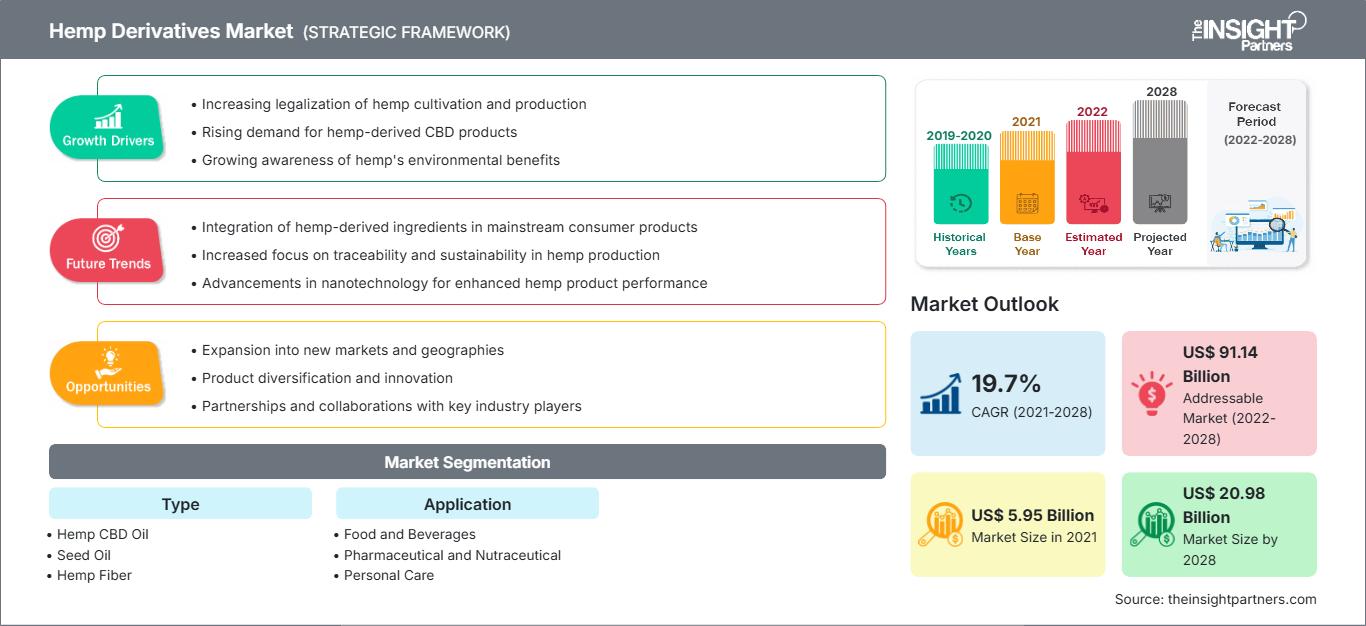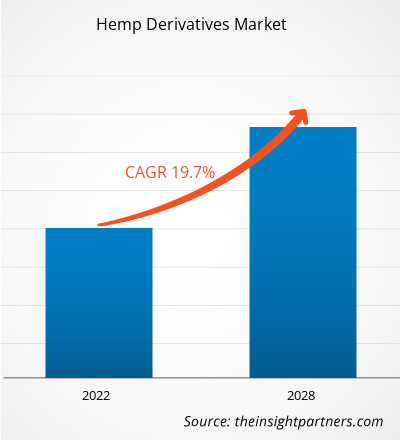2021年,大麻衍生物市场价值为59.5386亿美元,预计到2028年将达到209.7794亿美元;预计2021年至2028年的复合年增长率为19.7%。
工业大麻(Hemp)或工业大麻(Industrial Hemp)是指专门为工业用途种植的大麻属植物。大麻二酚(CBD)、籽油和纤维等大麻衍生物均源自大麻,广泛应用于食品饮料、药品、个人护理和动物饲料等多个终端行业。
2021年,亚太地区占据了全球大麻衍生物市场的最大份额。人们对大麻衍生物医疗益处的认识不断提高,这促进了其在该地区的应用。此外,大麻衍生物在纺织行业也有广泛的应用。此外,预计亚太地区化妆品和个人护理产品市场的蓬勃发展以及工业大麻在食品补充剂中的合法化将在预测期内推动该地区市场的发展。
持续的新冠疫情对大麻衍生物市场产生了相对积极的影响。这场疫情有助于提高人们对大麻医疗领域的认识和兴趣。这场危机对全球大多数人来说都是一段令人不快且充满压力的时期。因此,世界各地的人们开始消费大麻衍生产品来缓解焦虑和压力。一些重要的用户增加了大麻衍生产品的消费量。用于治疗睡眠障碍和抑郁症的消费量也呈夸张趋势。由于疫情期间人们对健康和保健的关注度增加,谷歌上关于大麻衍生物健康益处的搜索量也有所增加,这提高了人们对这些衍生物的认识。与此同时,许多国家在疫情期间遭遇税收短缺。各国政府正在寻找税收收入来源。潜在的推动力可能是大麻及其衍生物的合法化,这可能会逐渐引起人们的关注。合法卖家大麻及其衍生物销量的增加可以带来潜在的税收收入增长。
在新冠疫情期间,各种研究活动也集中于大麻及其衍生物在新冠治疗中的应用。加拿大的研究人员开展了一项研究,以确定大麻提取物是否有助于降低SARS-CoV-2病毒赖以入侵和传播的宿主细胞受体的水平。此外,总部位于以色列的STERO Biotech公司也对大麻和CBD作为新冠潜在治疗方法的应用提供了深入的见解。因此,各种针对大麻及其衍生物在新冠治疗中的应用的研究活动正在对大麻衍生物市场产生积极的影响。
自定义此报告以满足您的要求
您将免费获得任何报告的定制,包括本报告的部分内容,或国家级分析、Excel 数据包,以及为初创企业和大学提供超值优惠和折扣
大麻衍生品市场: 战略洞察

-
获取本报告的主要市场趋势。这个免费样本将包括数据分析,从市场趋势到估计和预测。
大麻在不同行业的应用日益广泛。大麻籽和油饼在食品和饮料行业中被用作食品和饲料蛋白的替代来源。此外,压榨大麻籽获得的油还用于制造肥皂、洗发水、乳液、化妆品和沐浴露。从大麻籽中提取的油富含氨基酸、矿物质和维生素,可用于营养补充剂以及医药和治疗产品。从大麻中提取的纤维含有大量的半纤维素,并且具有很强的吸收能力,这使其成为一种适用于纺织工业的作物。大麻的茎秆和纤维可用于制造服装、纸张、建筑材料、塑料和复合材料等。由于其高强度、可生物降解、热力学和轻质的特性,大麻纤维还用于制造绝缘材料和生物复合材料。大麻纤维在建筑行业中用于制造建筑材料,例如纤维板、灰泥和砂浆、水泥块、涂料、声学材料和管道包裹物。用于制造石油基产品的复合材料也由大麻制成。大麻籽富含营养和蛋白质,可以作为大豆的替代品。由于其蛋白质含量,大麻籽被用于生产主要的大豆制品,包括豆腐、黄油、奶酪、汉堡、冰淇淋和牛奶。因此,大麻衍生物在各行各业的应用日益广泛,导致对大麻衍生物的需求增加,从而推动了大麻衍生物市场的发展。
类型洞察
根据类型,大麻衍生物市场细分为大麻CBD油、种子油、大麻纤维和其他。大麻纤维在2021年占据了最大的市场份额。大麻是一种韧皮纤维植物,与黄麻、洋麻和亚麻类似。这些纤维由于其生物降解性以及比人造纤维更低的密度,目前被用作复合材料的增强材料。大麻纤维导热性好、防霉、染色性好、阻隔紫外线,并具有天然抗菌特性。
大麻衍生物市场的主要参与者包括:科罗拉多大麻制品公司 (Colorado Hemp Works, Inc)、Dun Agro Hemp Group、Ecofiber、Hempflax Group BV、Hempoland Sp. Z OO、Konoplex、Mh Medical Hemp Gmbh、Plains Industrial Hemp Processing Ltd、South Hemp 和 BAFA Neu GmbH。主要市场参与者正在采取并购和产品发布等策略,以扩大其地域覆盖范围和消费者群体。
报告重点
- 大麻衍生物行业的发展趋势,帮助参与者制定有效的长期战略
- 公司为确保在发达和发展中市场的增长而采取的业务增长战略
- 2019 年至 2028 年全球大麻衍生物市场的定量分析
- 估计各行业对大麻衍生物的需求
- 波特分析,说明行业买家和供应商预测市场增长的有效性
- 了解竞争激烈的市场形势和对大麻衍生物的需求的最新发展
- 市场趋势和前景,以及推动和抑制大麻衍生物市场增长的因素
- 了解支撑全球大麻衍生物市场增长商业利益的战略,有助于决策过程
- 不同市场节点的大麻衍生物市场规模
- 详细概述和细分全球大麻衍生品市场及其行业动态
- 各地区大麻衍生品市场规模及增长潜力
大麻衍生品市场
The Insight Partners 的分析师已详尽阐述了预测期内影响大麻衍生品市场的区域趋势和因素。本节还讨论了北美、欧洲、亚太地区、中东和非洲以及南美和中美洲的大麻衍生品市场细分和地域分布。
大麻衍生物市场报告范围
| 报告属性 | 细节 |
|---|---|
| 市场规模 2021 | US$ 5.95 Billion |
| 市场规模 2028 | US$ 20.98 Billion |
| 全球复合年增长率 (2021 - 2028) | 19.7% |
| 历史数据 | 2019-2020 |
| 预测期 | 2022-2028 |
| 涵盖的领域 |
By 类型
|
| 覆盖地区和国家 |
北美
|
| 市场领导者和主要公司简介 |
|
大麻衍生品市场参与者密度:了解其对商业动态的影响
大麻衍生物市场正在快速增长,这得益于终端用户需求的不断增长,而这些需求的驱动因素包括消费者偏好的不断变化、技术进步以及对产品益处的认知度不断提高。随着需求的增长,企业正在扩大产品范围,不断创新以满足消费者需求,并抓住新兴趋势,从而进一步推动市场增长。

- 获取 大麻衍生品市场 主要参与者概述
按类型划分的大麻衍生物市场
- 大麻 CBD 油
- 籽油
- 大麻纤维
- 其他
按应用划分的大麻衍生物市场
- 食品和饮料
- 药品和保健品
- 个人护理
- 纺织品
- 其他
公司简介
- Colorado Hemp Works, Inc
- Dun Agro Hemp Group
- Ecofiber
- Hempflax Group BV
- Hempoland Sp. Z OO
- Konoplex
- Mh 医用大麻有限公司
- Plains 工业大麻加工有限公司
- South Hemp
- BAFA Neu GmbH
- 历史分析(2 年)、基准年、预测(7 年)及复合年增长率
- PEST和SWOT分析
- 市场规模、价值/数量 - 全球、区域、国家
- 行业和竞争格局
- Excel 数据集
近期报告
客户评价
购买理由
- 明智的决策
- 了解市场动态
- 竞争分析
- 客户洞察
- 市场预测
- 风险规避
- 战略规划
- 投资论证
- 识别新兴市场
- 优化营销策略
- 提升运营效率
- 顺应监管趋势






















 获取免费样品 - 大麻衍生品市场
获取免费样品 - 大麻衍生品市场